Nissan confirms all-electric Micra successor for Europe

Nissan will launch an electric replacement for the Micra supermini based on a new EV platform shared with Renault as part of a €23 billion (£19bn) investment in electrification over the next five years announced by the Renault-Nissan-Mitsubishi Alliance.
The new Micra will share the planned new CMF-BEV platform with the upcoming Renault 5, the Alliance partners said in a joint announcement on Thursday.
The platform is set to be launched in 2024 and can accommodate enough batteries to provide a 250-mile range, the Alliance said. It will eventually form the basis for 250,000 vehicles annually by the Nissan, Renault and Alpine brands.
The platform is said to reduce costs by 33% and power consumption by 10% compared with the current platform used by the Renault Zoe supermini.
The CMF-BEV will be one of five electric platforms the Alliance will launch under a programme that was kicked off by the CMF-EV platform, which underpins the delayed Nissan Ariya SUV and the new Renault Mégane E-Tech Electric.
The five platforms include one specific to vans, other for Japanese-style micro Kei cars and the budget CMF-AEV platform as used for the Dacia Spring city car.
The Alliance said the five platforms will underpin 35 new cars by 2030.
Nissan said the shared platform “enables the companies to maintain unique styling for their respective products, as demonstrated by the design preview of the new vehicle.”
Nissan chief operating officer Ashwani Gupta said: “This all-new model will be designed by Nissan and engineered and manufactured by Renault using our new common platform, maximising the use of our Alliance assets while maintaining its Nissan-ness.
“This is a great example of the Alliance’s ‘smart differentiation’ approach. Succeeding our iconic Micra, I am sure this new model will provide further excitement to our customers in Europe.”
The three companies have sometimes struggled to find common ground in recent years as they tried to align competing demands but they have now said that shared electrification goals will unite the three and increase common investment.
“The Alliance is stronger than ever,” Jean-Dominique Senard, chairman of the Alliance, said. The money for electrification and connectivity projects represents “massive investments that none of the three companies could make alone,” Senard said.
